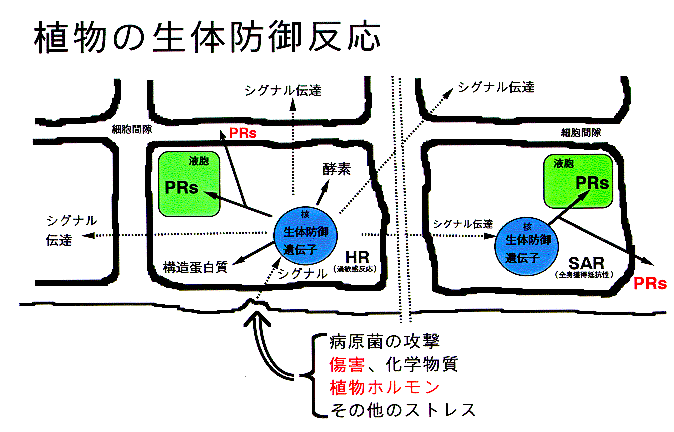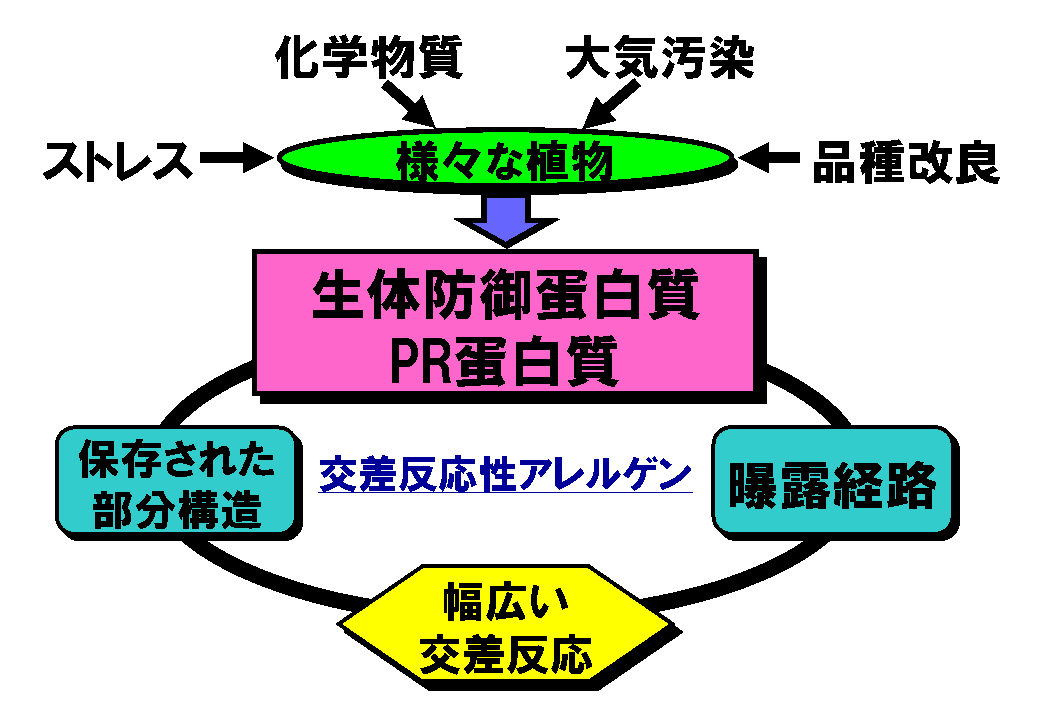植物の生体防御蛋白質
[ English | Japanese ]
 病原菌の感染や傷害、植物ホルモンを含めた化学物質や重金属の適用、オゾンなどの大気汚染物質、紫外線や厳しい生育環境など、様々なストレスを受けた植物は、その身を守るために一連の生体防御反応を起こします (図1) 。この過程で誘導される蛋白質群が、生体防御蛋白質(defense-related protein)です[1]。特に、農作物に病原菌が感染した際に誘導される抵抗性蛋白質については、農耕的な関心を元に古くから研究が進められ、感染特異的蛋白質(pathogenesis-related protein; PR蛋白質)と呼ばれてきました。また、イソフラボン還元酵素など、植物が誘導する低分子性抗菌物質(ファイトアレキシン)の生合成に関わる酵素群も、生体防御蛋白質の一種です。一方、種子や果実に蓄積される貯蔵蛋白質の多くは、栄養源の保存という役割に加え、外敵やストレス要因に対する構成的防御という働きを有すると考えられています。こうした動的あるいは静的な生体防御メカニズムは植物の進化過程で良く保存されており、形態学的には近縁種に属さない植物であっても、類似した抵抗性蛋白質を誘導あるいは蓄積することが知られています。例えば、現在までに多くの植物から見いだされたPR蛋白質は、由来する植物種に関係なく、アミノ酸配列の相同性や血清学的・免疫学的な相関性、酵素活性の特徴に基づいて、17のファミリーに分類されています(表)[2,3]。
病原菌の感染や傷害、植物ホルモンを含めた化学物質や重金属の適用、オゾンなどの大気汚染物質、紫外線や厳しい生育環境など、様々なストレスを受けた植物は、その身を守るために一連の生体防御反応を起こします (図1) 。この過程で誘導される蛋白質群が、生体防御蛋白質(defense-related protein)です[1]。特に、農作物に病原菌が感染した際に誘導される抵抗性蛋白質については、農耕的な関心を元に古くから研究が進められ、感染特異的蛋白質(pathogenesis-related protein; PR蛋白質)と呼ばれてきました。また、イソフラボン還元酵素など、植物が誘導する低分子性抗菌物質(ファイトアレキシン)の生合成に関わる酵素群も、生体防御蛋白質の一種です。一方、種子や果実に蓄積される貯蔵蛋白質の多くは、栄養源の保存という役割に加え、外敵やストレス要因に対する構成的防御という働きを有すると考えられています。こうした動的あるいは静的な生体防御メカニズムは植物の進化過程で良く保存されており、形態学的には近縁種に属さない植物であっても、類似した抵抗性蛋白質を誘導あるいは蓄積することが知られています。例えば、現在までに多くの植物から見いだされたPR蛋白質は、由来する植物種に関係なく、アミノ酸配列の相同性や血清学的・免疫学的な相関性、酵素活性の特徴に基づいて、17のファミリーに分類されています(表)[2,3]。
 注目すべきことにこのような生体防御蛋白質は、抗カビ活性や病害虫防除活性等を有することから、遺伝子組み換えによる抵抗性作物の創出など、植物育種への応用面で高い関心を集めている蛋白質群でもあります[4-8]。しかし最近、果物や野菜、花粉、天然ゴムラテックス等に含まれる交差反応性アレルゲンが、実は植物の生体防御に関与するような蛋白質群であることが次々と明らかにされてきました[9-11]。この事実は、植物に加わる様々なストレス、及び従来おこなわれてきたある種の品種改良や遺伝子組み換えによるストレス抵抗性植物の育種により、口腔アレルギー症候群(Oral Allergy Syndrone:OAS) 等のアレルギー疾患の誘発原因となる蛋白質が、農作物中に多く存在するようになってしまう可能性を示しています
(図2) [9-11]。遺伝子組み換えの手法を用いて新しく作成された農作物が食品として市場に出る際には、アレルギー誘発性を含めた安全性が厳重に評価・検討されることになっています[12]。
注目すべきことにこのような生体防御蛋白質は、抗カビ活性や病害虫防除活性等を有することから、遺伝子組み換えによる抵抗性作物の創出など、植物育種への応用面で高い関心を集めている蛋白質群でもあります[4-8]。しかし最近、果物や野菜、花粉、天然ゴムラテックス等に含まれる交差反応性アレルゲンが、実は植物の生体防御に関与するような蛋白質群であることが次々と明らかにされてきました[9-11]。この事実は、植物に加わる様々なストレス、及び従来おこなわれてきたある種の品種改良や遺伝子組み換えによるストレス抵抗性植物の育種により、口腔アレルギー症候群(Oral Allergy Syndrone:OAS) 等のアレルギー疾患の誘発原因となる蛋白質が、農作物中に多く存在するようになってしまう可能性を示しています
(図2) [9-11]。遺伝子組み換えの手法を用いて新しく作成された農作物が食品として市場に出る際には、アレルギー誘発性を含めた安全性が厳重に評価・検討されることになっています[12]。
表. 推奨されている感染特異的蛋白質 (PR蛋白質) の分類法
| ファミリー |
タイプメンバー |
特徴 |
| PR-1 |
タバコ PR-1a |
抗カビ活性?, 14-17kD |
| PR-2 |
タバコ PR-2 |
クラス I, II, III型 ベータ-1,3-グルカナーゼ, 25-35kD |
| PR-3 |
タバコ P, Q |
クラス I, II, IV, V, VI, VII型 エンドキチナーゼ, 約30kD |
| PR-4 |
タバコ R |
抗カビ活性, win類似蛋白質, エンドキチナーゼ活性,
プロヘベインのC-末端部領域に相同性, 13-19kD |
| PR-5 |
タバコ S |
抗カビ活性, タウマチン類似蛋白質,
オスモチン, ゼアマチン, パーメアチン,
アルファアミラーゼ/トリプシン阻害蛋白質に相同性 |
| PR-6 |
トマト インヒビター I |
プロテアーゼ阻害蛋白質, 6-13kD |
| PR-7 |
トマト P69 |
エンドプロテアーゼ |
| PR-8 |
キュウリ キチナーゼ |
クラス III型 キチナーゼ, キチナーゼ/リゾチーム |
| PR-9 |
リグニン合成ペルオキシダーゼ |
ペルオキシダーゼ, ペルオキシダーゼ類似蛋白質 |
| PR-10 |
パセリ PR-1 |
リボヌクレアーゼ, Bet v 1 に関連した蛋白質 |
| PR-11 |
タバコ クラス V型 キチナーゼ |
エンドキチナーゼ活性 |
| PR-12 |
ラディッシュ Ps-AFP3 |
植物ディフェンシン |
| PR-13 |
アラビドプシス THI2.1 |
チオニン |
| PR-14 |
大麦 LTP4 |
非特異的脂質輸送蛋白質 (ns-LTPs) |
| PR-15 |
大麦 OxOa (germin) |
シュウ酸酸化酵素 |
| PR-16 |
大麦 OxOLP |
シュウ酸酸化酵素類似蛋白質 |
| PR-17 |
タバコ PRp27 |
- |
その他、抗カビ活性や病害虫防除活性等を有する植物性蛋白質
2S 貯蔵アルブミン, パタチン, リボソーム不活性化蛋白質 (RIPs), ポリガラクツロナーゼ阻害蛋白質 (PGIPs), 非酵素的キチン結合性蛋白質 (ヘベイン, レクチン類, AMPs, AFPs, etc.), シスタチン, プロラミン貯蔵蛋白質, ビシリン (7S) 貯蔵蛋白質, ・・・・・
参考文献
[1] Bowles, D.J.: Defense-related proteins in higher plants., Annu. Rev. Biochem., 59, 873-907 (1990).
[2] Van Loon, L.C., Pierpoint, W.S., Boller, Th. and Conejero, V.: Recommendations for naming plant pathogenesis-related proteins., Plant Mol. Biol. Report.,12, 245-264 (1994); Van Loon, L.C. and Van Strien, E.A.: The families of pathogenesis-related proteins, their activities, and comparative analysis of PR-1 type proteins., Physiol. Mol. Plant Pathol., 55, 85-97 (1999).
[3] Fritig, B., Heitz, T. and Legrand, M.: Antimicrobial proteins in induced plant defense., Curr. Opin. Immunol., 10, 16-22 (1998).
[4] Lee, H.-I. and Raikhel, N.V.: Prohevein is poorly processed but shows enhanced resistance to a chitin-binding fungus in transgenic tomato plants., Braz. J. Med. Biol. Res., 28, 743-750 (1995); Kanrara, S., Venkateswaria, J.C., Kirtib, P.B. and Chopra, V.L.: Transgenic expression of hevein, the rubber tree lectin, in Indian mustard confers protection against Alternaria brassicae., Plant Sci., 162, 441-448 (2002).
[5] Shah, D.M.: Genetic engineering for fungal and bacterial diseases., Curr. Opin. Biotechnol., 8, 208-214 (1997).
[6] Shewry, P.R. and Lucas J.A.: Plant proteins that confer resistance to pests and pathogens., Adv. Bot. Res., 26, 135-192 (1997).
[7] 山田哲治, 島本 功, 渡辺雄一郎 監修: 分子レベルからみた植物の耐病性, 細胞工学別冊 植物細胞工学シリーズ8, 秀潤社 (1997). ISBN 4-87962-175-7
[8] 西澤洋子, 鈴木 匡, 日比忠明: 病害抵抗性トランスジェニック植物の開発はどこまで進んだか, 化学と生物, 37, 295-305 (1999).
[9] 小川 正: 果物, 野菜, 穀物アレルゲンと植物防御タンパク質, アレルギー・免疫, Vol.8, No.8, 902-909 (2001); Breiteneder, H.: Plant-food and seafood allergens - an overview., Allergy, 53 (Suppl 46), 31-34 (1998); Vieths, S., Scheurer, S. and Ballmer-Weber, B.: Current understanding of cross-reactivity of food allergens and pollen., Ann. N. Y. Acad. Sci., 964, 47-68 (2002); van Ree R.: Clinical importance of cross-reactivity in food allergy., Curr. Opin. Allergy Clin. Immunol., 4, 235-240 (2004).
[10] Hanninen, A.R., et al.: Increased allergen production in turnip (Brassica rapa) by treatments activating defense mechanisms., J. Allergy Clin. Immunol., 104, 194-201 (1999); Hanninen, A.R., et al.:Prohevein-like defense protein of tobacco is a cross-reactive allergen for latex-allergic patients., J. Allergy Clin. Immunol., 106, 778-779 (2000); Armentia, A., et al.: Is Lolium pollen from an urban environment more allergenic than rural pollen?, Allergol. Immunopathol.
(Madr.), 30, 218-224 (2002); Armentia, A., et al.: Enhancement of tomato allergenicity after treatment with plant hormones., Allergol. Immunopathol. (Madr.), 31, 44-46 (2003); Krebitz, et al.: Plant-based heterologous expression of Mal d 2, a thaumatin-like protein and allergen of apple (Malus domestica), and its characterization as an antifungal protein., J. Mol. Biol., 329, 721-730 (2003); Cortegano, I., et al.: Cloning and expression of a major allergen from Cupressus arizonica
pollen, Cup a 3, a PR-5 protein expressed under polluted environment., Allergy, 59, 485-490 (2004); Chehregani, A., et al.: Increasing allergy potency of Zinnia pollen grains in polluted areas., Ecotoxicol. Environ. Saf., 58, 267-272 (2004); Tashpulatov, A.S., et al.: A model system to study the environment-dependent expression of the Bet v 1a gene encoding the major birch pollen allergen., Int. Arch. Allergy Immunol., 134, 1-9 (2004).
[11] 小川 正: 食品アレルギーを誘発する植物起源アレルゲン, 化学と生物, 40, 643-652 (2002); Salcedo, G., Diaz-Perales, A. and Sanchez-Monge, R.: Fruit allergy: plant defence proteins as novel potential panallergens., Clin. Exp. Allergy., 29, 1158-1160 (1999); Breiteneder, H. and Ebner, C.: Molecular and biochemical classification of plant-derived food allergens., J. Allergy Clin. Immunol., 106, 27-36 (2000); Hoffmann-Sommergruber, K.: Plant allergens and
pathogenesis-related proteins., Int. Arch. Allergy Immunol., 122, 155-166 (2000); Ebner, C., Hoffmann-Sommergruber, K. and Breiteneder, H.: Plant food allergens homologous to pathogenesis-related proteins., Allergy, 56(Suppl.67), 43-44 (2001); Midoro-Horiuti, T., Brooks, E.G. and Goldblum, R.M.: Pathogenesis-related proteins of plants as allergens., Ann Allergy Asthma Immunol, 87, 261-271 (2001); Breiteneder, H. and Ebner, C.: Atopic allergens of plant foods., Curr. Opin. Allergy Clin.
Immunol., 1, 261-267 (2001); Hoffmann-Sommergruber, K.: Pathogenesis-related (PR)-proteins identified as allergens., Biochem. Soc. Trans., 6, 930-935 (2002).
[12] Taylor, S.L.: Protein allergenicity assessment of foods produced through agricultural biotechnology., Annu. Rev. Pharmacol. Toxicol., 42, 99-112 (2002); BSACI working party: Lack, G., et al.: Report on the potential allergenicity of genetically modified organisms and their products., Clin. Exp. Allergy, 32, 1131-1143 (2002); Fu, T.J., Abbott, U.R. and Hatzos, C.: Digestibility of food allergens and nonallergenic proteins in simulated gastric fluid and simulated intestinal fluid - A comparative study.,
J. Agric. Food Chem., 50, 7154-7160 (2002); Brusic, V. and Petrovsky, N.: Bioinformatics for characterisation of allergens, allergenicity and allergic crossreactivity., Trends Immunol., 24, 225-228 (2003); Fiers, M. W.E.J., et al.,: Allermatch, a webtool for the prediction of potential allergenicity according to current FAO/WHO Codex alimentarius guidelines., BMC Bioinformatics, 5(1), 133 (2004); Jenkins, J.A., et al.; Structural relatedness of plant food allergens with specific reference to
cross-reactive allergens: an in silico analysis., J. Allergy Clin. Immunol., 115163-170 (2005).
医療機器部のホームページに戻る
NIHS / DMD / iryokiki@nihs.go.jp 学術的に参考になると思われるサイトに、リンクを張らせていただきました。もし不都合等がありましたら直ちにリンクを解除・変更いたしますので、ご連絡下さい。
 注目すべきことにこのような生体防御蛋白質は、抗カビ活性や病害虫防除活性等を有することから、遺伝子組み換えによる抵抗性作物の創出など、植物育種への応用面で高い関心を集めている蛋白質群でもあります[4-8]。しかし最近、果物や野菜、花粉、天然ゴムラテックス等に含まれる交差反応性アレルゲンが、実は植物の生体防御に関与するような蛋白質群であることが次々と明らかにされてきました[9-11]。この事実は、植物に加わる様々なストレス、及び従来おこなわれてきたある種の品種改良や遺伝子組み換えによるストレス抵抗性植物の育種により、口腔アレルギー症候群(Oral Allergy Syndrone:OAS) 等のアレルギー疾患の誘発原因となる蛋白質が、農作物中に多く存在するようになってしまう可能性を示しています
(図2) [9-11]。遺伝子組み換えの手法を用いて新しく作成された農作物が食品として市場に出る際には、アレルギー誘発性を含めた安全性が厳重に評価・検討されることになっています[12]。
注目すべきことにこのような生体防御蛋白質は、抗カビ活性や病害虫防除活性等を有することから、遺伝子組み換えによる抵抗性作物の創出など、植物育種への応用面で高い関心を集めている蛋白質群でもあります[4-8]。しかし最近、果物や野菜、花粉、天然ゴムラテックス等に含まれる交差反応性アレルゲンが、実は植物の生体防御に関与するような蛋白質群であることが次々と明らかにされてきました[9-11]。この事実は、植物に加わる様々なストレス、及び従来おこなわれてきたある種の品種改良や遺伝子組み換えによるストレス抵抗性植物の育種により、口腔アレルギー症候群(Oral Allergy Syndrone:OAS) 等のアレルギー疾患の誘発原因となる蛋白質が、農作物中に多く存在するようになってしまう可能性を示しています
(図2) [9-11]。遺伝子組み換えの手法を用いて新しく作成された農作物が食品として市場に出る際には、アレルギー誘発性を含めた安全性が厳重に評価・検討されることになっています[12]。
 病原菌の感染や傷害、植物ホルモンを含めた化学物質や重金属の適用、オゾンなどの大気汚染物質、紫外線や厳しい生育環境など、様々なストレスを受けた植物は、その身を守るために一連の生体防御反応を起こします (図1) 。この過程で誘導される蛋白質群が、生体防御蛋白質(defense-related protein)です[1]。特に、農作物に病原菌が感染した際に誘導される抵抗性蛋白質については、農耕的な関心を元に古くから研究が進められ、感染特異的蛋白質(pathogenesis-related protein; PR蛋白質)と呼ばれてきました。また、イソフラボン還元酵素など、植物が誘導する低分子性抗菌物質(ファイトアレキシン)の生合成に関わる酵素群も、生体防御蛋白質の一種です。一方、種子や果実に蓄積される貯蔵蛋白質の多くは、栄養源の保存という役割に加え、外敵やストレス要因に対する構成的防御という働きを有すると考えられています。こうした動的あるいは静的な生体防御メカニズムは植物の進化過程で良く保存されており、形態学的には近縁種に属さない植物であっても、類似した抵抗性蛋白質を誘導あるいは蓄積することが知られています。例えば、現在までに多くの植物から見いだされたPR蛋白質は、由来する植物種に関係なく、アミノ酸配列の相同性や血清学的・免疫学的な相関性、酵素活性の特徴に基づいて、17のファミリーに分類されています(表)[2,3]。
病原菌の感染や傷害、植物ホルモンを含めた化学物質や重金属の適用、オゾンなどの大気汚染物質、紫外線や厳しい生育環境など、様々なストレスを受けた植物は、その身を守るために一連の生体防御反応を起こします (図1) 。この過程で誘導される蛋白質群が、生体防御蛋白質(defense-related protein)です[1]。特に、農作物に病原菌が感染した際に誘導される抵抗性蛋白質については、農耕的な関心を元に古くから研究が進められ、感染特異的蛋白質(pathogenesis-related protein; PR蛋白質)と呼ばれてきました。また、イソフラボン還元酵素など、植物が誘導する低分子性抗菌物質(ファイトアレキシン)の生合成に関わる酵素群も、生体防御蛋白質の一種です。一方、種子や果実に蓄積される貯蔵蛋白質の多くは、栄養源の保存という役割に加え、外敵やストレス要因に対する構成的防御という働きを有すると考えられています。こうした動的あるいは静的な生体防御メカニズムは植物の進化過程で良く保存されており、形態学的には近縁種に属さない植物であっても、類似した抵抗性蛋白質を誘導あるいは蓄積することが知られています。例えば、現在までに多くの植物から見いだされたPR蛋白質は、由来する植物種に関係なく、アミノ酸配列の相同性や血清学的・免疫学的な相関性、酵素活性の特徴に基づいて、17のファミリーに分類されています(表)[2,3]。